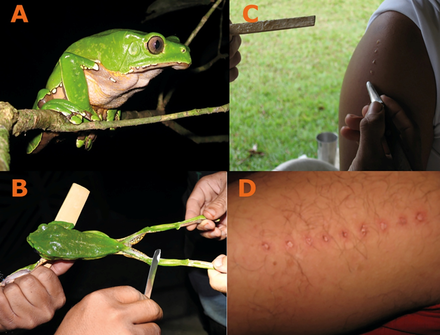The Kambo fad: people are applying frog poison to burns created on their skin, making them vomit repeatedly and feel terrible. They think this torture has health benefits. There’s no evidence that it does anything but poison them. Could anything be more ridiculous?

2020 was a terrible year in many ways. Sometimes I felt like the whole world was going crazy. I was feeling more optimistic about 2021; but on January 1, 2021, The New York Times started off the New Year with an article that reminded me that there was still a lot of craziness in the world of alternative medicine, maybe more than ever.
The Amazonian giant monkey frog secretes poison from its skin when it feels threatened. Long used by Amazonian tribes to treat various illnesses, increase stamina, induce abortions, and ward off bad luck, kambo has become a New Age fad in the US. People who take it vomit repeatedly and feel worse than they have ever felt before. Afterwards, they say they feel as if they have been cleansed both physically and psychologically. Many choose to repeat the experience multiple times.
The ceremony
A ceremony in Berkeley, California, is described that costs $150. Attendees are instructed to prepare with a 3-day cleanse, eliminating sugar, alcohol, pharmaceuticals, meat, gluten, and dairy. The ceremony environment features Eastern prayer cards, crystals, sage, and meditative music. Powdered tobacco is blown up the nostrils, making you feel “like you’ve been pleasantly electrocuted”. Next, a drop of sananga, an Amazonian plant extract, is put into the eyes, described as feeling “like you’re burning your cornea”. The frog is captured, restrained, and essentially tortured to make it feel threatened so it will secrete drops of poison from its skin. Animal cruelty? Does the SPCA know about this? A glowing ember is used to produce tiny burns on the person’s skin, the blisters are wiped away, and a kambo-treated stick is applied to the open wounds. Within minutes, there is a flood of adverse effects: rapid heart rate, headache, flushing and swelling of the face (known as “frog face”), diarrhea, and profuse vomiting.
The claims
According to Wikipedia, kambo is used to purge toxins and psychological traumas from the body; to treat addiction, depression, and chronic pain; to reduce fevers, increase fertility; to boost energy and physical strength; and to improve mental clarity. It is also claimed to remove negative energy and cleanse the soul and body. Testimonials report feelings of invincibility, superpower immunity, purging of internalized anger from a divorce, feeling lighter, having fewer migraines, “a quietness in my soul”, and more.
The Psychedelic Times lists even more uses, including cancer, infections, Alzheimer’s, and Parkinson’s disease.
The evidence: There isn’t any
Kambo has never been tested in clinical trials, and there is no evidence to support the claims. It is a poison with no known benefits and is reported to have caused numerous adverse reactions, hospitalizations, and even several deaths.
This all sounded so monumentally silly that at first I thought it must be a spoof, but a little research convinced me that the kambo fad is very real. Its use is reported by several reputable news sources, it has its own Wikipedia page, and even has its own professional organization, the International Association of Kambo Practitioners, that claims to have trained over 400 practitioners.
Conclusion: It’s poison, not medicine
If putting frog poison in open wounds isn’t the worst idea alternative medicine has ever come up with, I don’t know what is. It deserves some kind of award: for quackery? Frogs croak, and croak translates into German as das Quaken, which sounds similar to quackery. Or perhaps we should call it ribbetry? Whatever. Kambo is not what it’s “quacked up to be”, although the descriptions of the tortures inflicted on frogs and humans are as “ribbeting” as any horror story. I strongly recommend you “froget” about trying kambo.
But as the New York Times article pointed out,
The idea of a body-shaking cleanse through projectile vomiting seems like an oddly appropriate response to a toxic year.
This article was originally published in the Science-Based Medicine Blog.
